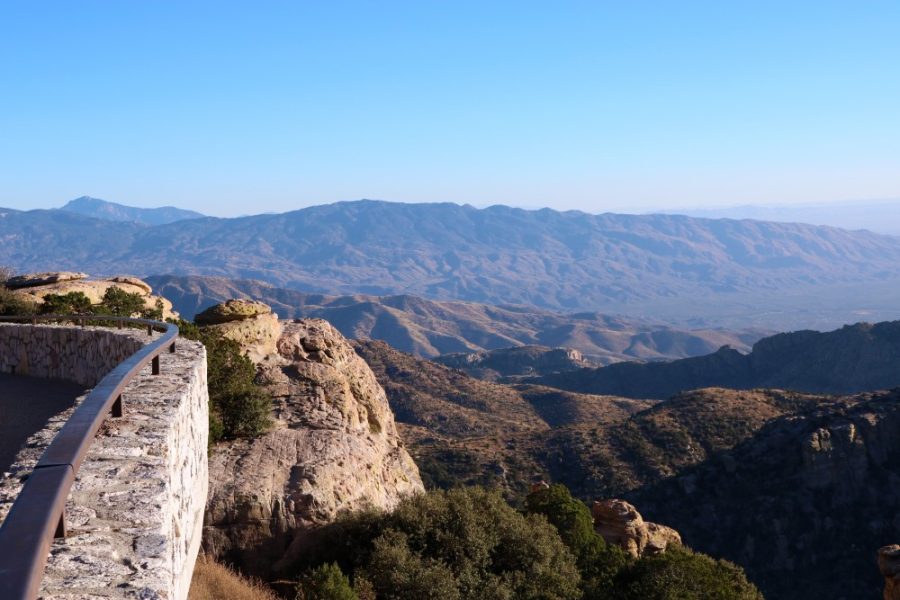The UA’s Critical Zone Observatory, located in the Santa Catalina Mountains, is a research facility funded by the National Science Foundation, an independent federal agency.
The main objective of the CZO is to study a specific ecosystem and then use that information to predict how the “critical zone” may react to variables such as climate change in the future. One of the CZO’s focus areas within the Catalinas is Mount Bigelow, a summit adjacent to Mount Lemmon.
“The CZO is a place where we have a lot of different scientists from different departments and different specialties all working together in one location,” said Rebecca Minor, a research specialist in the School of Geography and Development.
With a grant from the National Science Foundation most recently renewed in 2014, scientists from many different departments will be able to continue to do research at the Observatory, according to Minor.
The CZO itself was created in 2009 and is one of only six NSF-funded observatories in the U.S., according to Minor.
“One interesting thing about this particular spot is that [the CZO] is the only one that is in a semi-arid area, and it’s the only one in the Southwest,” Minor said.
This makes it an important piece to the puzzle, as many places on earth share similar climates to ours, according to Minor.
The extension of the grant will also make it possible to study the natural differences from year to year in a specific region, Minor said. This can be very helpful because there are different factors that influence how plant processes will work over time.
“We want to know what to prepare for, if climate change is going to have an impact on these forests or not. And we can really only do that if we have a really strong understanding of how the forests and other ecosystems function now,” said Patrick Murphy, a graduate student in the School of Geography and Development.
The CZO’s research centers on an area of earth known as the ‘critical zone’. The critical zone is the zone right around the earth’s crust where all living things exist and a lot of chemical processes happen.
It begins at the bedrock layer and extends up through several layers of the atmosphere in order to encompass the air we breathe, Minor said.
Because we depend on the critical zone for clean air, water and food, it’s important for researchers to do everything they can to study it.
The interconnected, interdisciplinary structure of the CZO allows researchers who wouldn’t usually communicate with each other to work together, bringing a new perspective to earth sciences, Murphy said.
This connectedness creates an environment where researchers can work together to test their hypotheses and conduct experiments.
“My thesis project is trying to get a better understanding of the complexity in how forests function, depending on how topography is different,” Murphy said. “I hope to inform some of the models the CZO group is collectively putting together.”
Studying topography involves other areas of research at the CZO, such as soil creation, erosion, and movement of energy, Murphy said.
RELATED: Grasslands imperiled by climate change
Rachel Gallery, a UA assistant professor of microbial ecology, also conducts research at the CZO. She focuses on the soil microbiome and studies soil microbes from the soil surface down to the bedrock level. This helps us understand how soil forms, especially in extreme environments, Gallery said.
“Microbes are one of the most key, important players in helping maintain soil health and soil fertility,” Gallery said. “They provide us with those ecosystem services that we rely on to grow our food.”
Aside from conducting science research, the CZO also focuses on education and outreach, according to Minor.
Engaging with the public and with state representatives is important, as it is our responsibility to bring issues such as climate change into the spotlight, Gallery said. She is currently involved in a research initiative called 500 Women Scientists, which focuses on increasing diversity in the science world.
Minor said other CZO outreach programs include offering sites for classes to come and conduct field experiments, presenting research at conferences, and involving undergraduate and graduate researchers.
RELATED: 400 parts per million: We’ve reached a climate change ‘tipping point’
While the CZO puts a strong emphasis on scientific research, collaborating with other CZO scientists across the nation and sharing findings with the public is equally important, Minor said. She explained that without the grant from the NSF and tax money from citizens across America, this research would not be possible.
“We feel very happy to have gained that vote of confidence to continue our research,” Minor said. “I think it’s really important to do the research and share it with anyone who is interested, because everyone in the United States is essentially providing us with this opportunity through the federal government.”
To learn more about what is going on at the Critical Zone Observatory and how you can get involved, check out its website. The CZO regularly conducts talks and exhibits, making its research available to the public.
Follow Hannah Dahl on Twitter.









